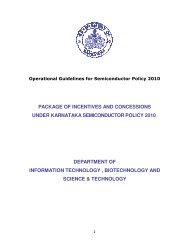IT.Biz 2011 -India: A hub for global electronics manufacturing? A ...
IT.Biz 2011 -India: A hub for global electronics manufacturing? A ...
IT.Biz 2011 -India: A hub for global electronics manufacturing? A ...
- No tags were found...
You also want an ePaper? Increase the reach of your titles
YUMPU automatically turns print PDFs into web optimized ePapers that Google loves.
<strong>IT</strong>.<strong>Biz</strong> <strong>2011</strong>-<strong>India</strong>: A <strong>hub</strong> <strong>for</strong> <strong>global</strong> <strong>electronics</strong><strong>manufacturing</strong>?A. GururajOctober <strong>2011</strong>© QUAD
Agenda1. Emerging Trends in EMS: Global & <strong>India</strong>n Scenario2. <strong>India</strong> Competitiveness3. Vittal Innovation City/Quad Electronics
1EmergingTrends in EMS: Global &<strong>India</strong>n Scenario© QUAD
Emergence of a New Era in <strong>India</strong>n EMS• With the launch of the “Aakash”, the world’s cheapest tablet PC, made in <strong>India</strong>, a new erahas emerged <strong>for</strong> the <strong>India</strong>n Electronics Manufacturing Services (EMS) and in general the<strong>India</strong>n <strong>electronics</strong> hardware industry.• Manufactured at QUAD Electronic Solutions Pvt., Ltd. an <strong>India</strong>n EMS company located inHyderabad, the launch of the “Aakash” signals start of a phase of possibilities of highvolume <strong>electronics</strong> <strong>manufacturing</strong> <strong>for</strong> <strong>India</strong>n markets <strong>for</strong> products <strong>for</strong> products other thanmobile phones.• The National Mission on Education with a budget of Rs 4612 crores looks to reach out tohigher education and faculty population of around 22 million, thus creating large volumedevice <strong>manufacturing</strong> requirements in <strong>India</strong>.• The ef<strong>for</strong>ts of QUAD Electronics and the designers of the product are an example of the<strong>India</strong>’s capability to cater to cutting edge technology at prices <strong>global</strong>ly competitive.© QUAD
The <strong>global</strong> market <strong>for</strong> <strong>electronics</strong> is growing at a rapidpace….• The 13th WEF in Tel Aviv reported the <strong>global</strong> <strong>electronics</strong> industry at US$ 1.7Trillion – the largest and fastest growing <strong>manufacturing</strong> industry.• There was a moderately healthy EMS & ODM growth with a CAGR of11.9% in EMS and 11.4% in ODM.• Production capacity is concentrated in Asia with a 55% share. Remainingcapacity is spread across Americas (25%) and Europe (20%). Asia’s shareexpected to rise further to 69% shrinking the share of the Americas to 17%and Europe to 14%.• ODM production concentrating at 96% in Asia, 2% in Americas and 2% inEurope, with stabilization expected at 90% Asia , 5% Americas & 5%Europe.© QUAD
The <strong>India</strong>n <strong>electronics</strong> demand is growing even quicker,intensifying demand <strong>for</strong> local <strong>manufacturing</strong>….• Current <strong>India</strong>n <strong>electronics</strong> market is valued at US$ 40Billion. The market is growing at ~ 25%and would exceed US$ 400 Billion by 2020.• The present domestics production is ~$20 Billion - about 50% of the domestic demand!• Domestic companies can expand the production to USD 85 Billion by 2014 and USD 320 billionby 2020. This would constitute a very significant contribution to the GDP, at 20% <strong>for</strong> 2020, atpar with other economies.5002500Projected demand-supply gap in <strong>electronics</strong> industry (USD billion)400320125854510426 42FY09 FY14 FY20Total demand Domestic production (target) Domestic production (at current CAGR)Production level <strong>electronics</strong>industry may reach with favorablepolicy environmentGap between current andexpected domestic production,offering significant opportunities<strong>for</strong> improvementProduction level <strong>electronics</strong>industry will reach with currentpolicy environment<strong>India</strong>’s import bill <strong>for</strong> <strong>electronics</strong> is projected to be bigger than it’s import bill <strong>for</strong> oil.© QUAD
…The <strong>India</strong>n Market <strong>for</strong> Electronics will witness adramatic growth fueled by consumptionDrivers <strong>for</strong> Growth in <strong>India</strong>nElectronics Consumption.• Rise in disposable incomeleading to growth indemand <strong>for</strong> consumer<strong>electronics</strong>• Increasing Telecompenetration including voiceand broadband, coupledwith next-generationlaunches like 3G/4G.Consumption Billion $ 2005 2015GlobalsCream of countryMiddle ClassSuccessful workingclassAspirersService, SmallFarmers24 8262 280170 244Figure: Projected increase in consumption of <strong>India</strong>n population<strong>India</strong>n Defense Electronics MarketIn $ Million• Increasing Governmentspend on broadbandinfrastructure and defenceFigure: Projected market <strong>for</strong> Defense <strong>electronics</strong> in <strong>India</strong>The <strong>India</strong>n Government has initiated major projects such as the National Broadband Plan, National KnowledgeNetwork, National e-Governance plan, Smart Grid and the Student Laptop project with a projected total<strong>electronics</strong> spend of $35 Billion
<strong>India</strong>n Electronic Ind. – Sector wise RevenueDecember, 2010 | © QUAD
Business Opportunities- Telecom• Mobile Handsets• Market Scenario• Handset Sales in 2009 --- Global – 1.12 billion ; <strong>India</strong> – 130 million units• <strong>India</strong> market growing at 15% p.a.• Total handset demand in <strong>India</strong>/SE Asia/Africa – 330 Mn units by 2014• Market size – Rs.85000 crores.• Opportunities in handsets• Branded players constitute 65% of the market• Emergence of mid-tier players viz., Micromax, Lava, Karbonn etc.• 600% increase in phones shipped by mid-tier players in <strong>India</strong> within a period of oneyear• Success of ODM device strategy – example: MicromaxDecember, 2010 | © QUAD
Opportunities <strong>for</strong> InvestmentsIndustry SegmentsThe various segments of the <strong>electronics</strong> industry need to be given an impetus. Each segment of the <strong>electronics</strong>ecosystem varies in the extent of value addition it requires, its contribution to the economy and its future growthpotential. These factors have been elaborated on in the matrix below:December, 2010 | © QUAD
2<strong>India</strong>Competitiveness© QUAD
According to Deloitte, <strong>India</strong> is the second most competitive<strong>manufacturing</strong> location worldwideKey reasons <strong>for</strong> <strong>India</strong>’s competitiveness are:1) Labour cost2) Skilled labour3) English speaking engineers• In the study, the top drivers <strong>for</strong> competitiveness score were talent driven innovation, labor and rawmaterial costs and energy costs and policies, in that order.• Ascent of <strong>India</strong> underlines the importance of R&D strength coupled with engineering, software andtechnology integration abilities.• <strong>India</strong> is now viewed as a place to design, develop and manufacture products <strong>for</strong> local as well as<strong>global</strong> markets.• <strong>India</strong>n is ranks favorably on IP protection & copyright environment versus other countries in thestudy.Source: Deloitte© QUAD
Cost Savings in <strong>India</strong> Sourcing: Commodities wiseCommodity %Packing & manual 10Hardware fasteners & others 7Aluminium Die Cast 6Machined Parts 5Aluminium Heat Sinks 3Hard Tools Stamped Parts 3Accessories, cables & chargers 3© QUAD
<strong>India</strong> compares favorably in terms of wages and availabilityof labour•<strong>India</strong> is cheaper than China in terms of <strong>manufacturing</strong> wages per hourManufacturing Wages (USD per hour)Availability of skilled labour (1=Low,10=High)Availability of qualified engineers (1=Low,10=High)USA20.3<strong>India</strong>8.9Japan19.0Singapore7.9Korea8.4USA7.3Singapore7.8Mexico6.4Taiwan6.1Taiwan6.6Mexico2.3Korea5.7China0.8Mexico5.3<strong>India</strong>0.4China3.9Source: KPMG & IMD Competitiveness YearbookLabour arbitrage is important interms of the feasibility of theelectronic components industryElectronics manufacturers in <strong>India</strong> statethat the knowledge of English in thisresource pool expedites the pace andquality of technology transfer<strong>India</strong>n produces 400,000 Engineers in ayear as Engineering and Medicine arehighly sought after degress in the <strong>India</strong>npsyche.
There are, however, impediments to efficient <strong>manufacturing</strong>in <strong>India</strong> such as Infrastructure, Procedural delay & Labor laws.Cost of power to industrial consumersSource: IMD Competitiveness Yearbook 2003Bottlenecks to Trade, <strong>India</strong> vs China§ Infrastructure- China invests 2.5 percent of its GDP on roads asagainst 0.3 percent in <strong>India</strong>- Power to industrial consumers is twice asexpensive in <strong>India</strong> as against China- Due to frequent outages, most units need togenerate their own captive power§ Procedural delays- Delays at port and poor infrastructure from portsin terms of roads, rail etcProcessing time atcustoms <strong>for</strong>importsTime at customs<strong>for</strong> exportsLoading/unloadingat port0.60.6210.010.010.0§ Labour regulations- World Economic Forum (WEF) ranks <strong>India</strong> as 96thamong 102 countries in terms of hire and firepolicies; China ranks 26th- China has pursued labour re<strong>for</strong>m includingcontract labour, and hire & fire policies since itinitiated its liberalization process© QUADSource: CII and McKinsey
The government has acted on some of the factorsThe <strong>India</strong>n Government has set up Export processing zones-EHTP & SEZs. EHTPs to make it easier <strong>for</strong>manufacturers to export goods from their current facilities while SEZs to develop export oriented<strong>manufacturing</strong> clustersSEZ/EHTP Advantages• Infrastructure• Dedicated infrastructure <strong>for</strong> roads, uninterrupted power, water and communications.• Public & Private partnership model• Incentives to private developers to stimulate investments in infrastructure• Procedures• Single window & faster clearances <strong>for</strong> Central and State approvals.• Labor Regulations• Proposed Manufacturing policy advocates relaxed labor laws while placing the responsibility ofpreventing labor exploitation on SEZ Authority, instead of individual units.• Fiscal Incentives• No customs/import duties and local duties <strong>for</strong> inputs• No excise, export duties, income tax or sales tax on final product• Bank finance on priority basis and at concessional rate of interest© QUAD
In Conclusion: Outlook <strong>for</strong> <strong>India</strong>n Electronics Manufacturing•Clear trends:•Exponential increase in local and <strong>global</strong> demand•Shift of mass <strong>manufacturing</strong> base to Asia•Government’s realization of <strong>electronics</strong> <strong>manufacturing</strong>’s importance•Shrinking time-to-market timelines•Global OEMs de-risking China•The <strong>India</strong>n Companies who would do well will have:•Right combination of <strong>India</strong>n and <strong>global</strong> customers•Strong sourcing network throughout Asia•Prototyping and High Mix-Low volume presence near <strong>global</strong> OEMs <strong>for</strong>shorter time to market•Mass <strong>manufacturing</strong> bases in <strong>India</strong> <strong>for</strong> local sales and exports from SEZs•End-to-end design, prototyping, sourcing, <strong>manufacturing</strong> and logisticscapabilities.© QUAD
Questions & Answers© QUAD













